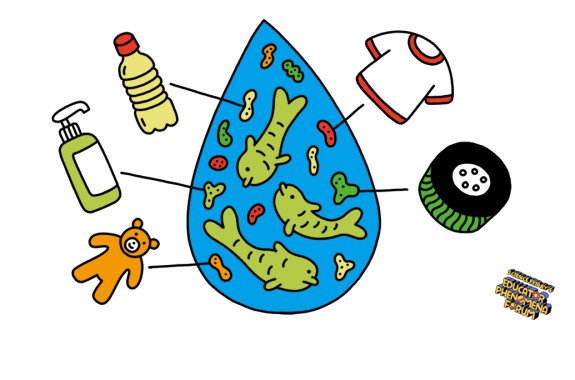Grade Level
3-4
minutes
1- 2 hrs
subject
Environmental Science
stem practices
Developing and Using Models
Activity Type:
 This resource is part of Science Friday’s Educator Phenomena Forum and was developed collaboratively by Chenille Williams, an educator at the Richland County Department of Public Works, and Timnit Kefela, a Ph.D. candidate at University California Davis specializing in microplastics pathways. Click here for a folder of classroom resources.
This resource is part of Science Friday’s Educator Phenomena Forum and was developed collaboratively by Chenille Williams, an educator at the Richland County Department of Public Works, and Timnit Kefela, a Ph.D. candidate at University California Davis specializing in microplastics pathways. Click here for a folder of classroom resources.
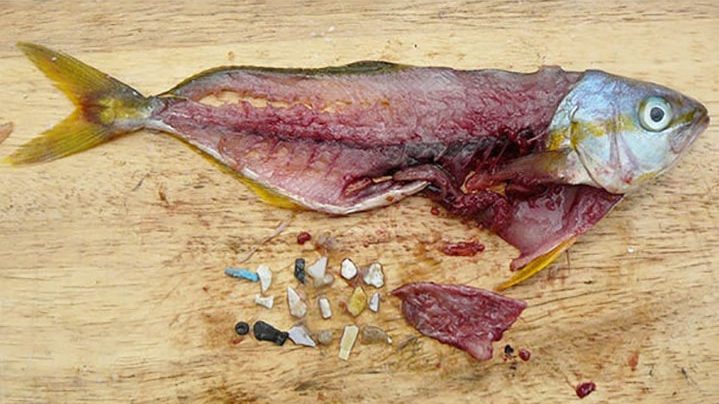
Take a moment to examine the image of a Rainbow Runner fish above. What do you notice? What do you wonder?
Keep track of your ideas on the Microplastic Design Worksheet.
Now take a look at the graph below (be sure to examine all labels). What do you notice? What do you wonder?
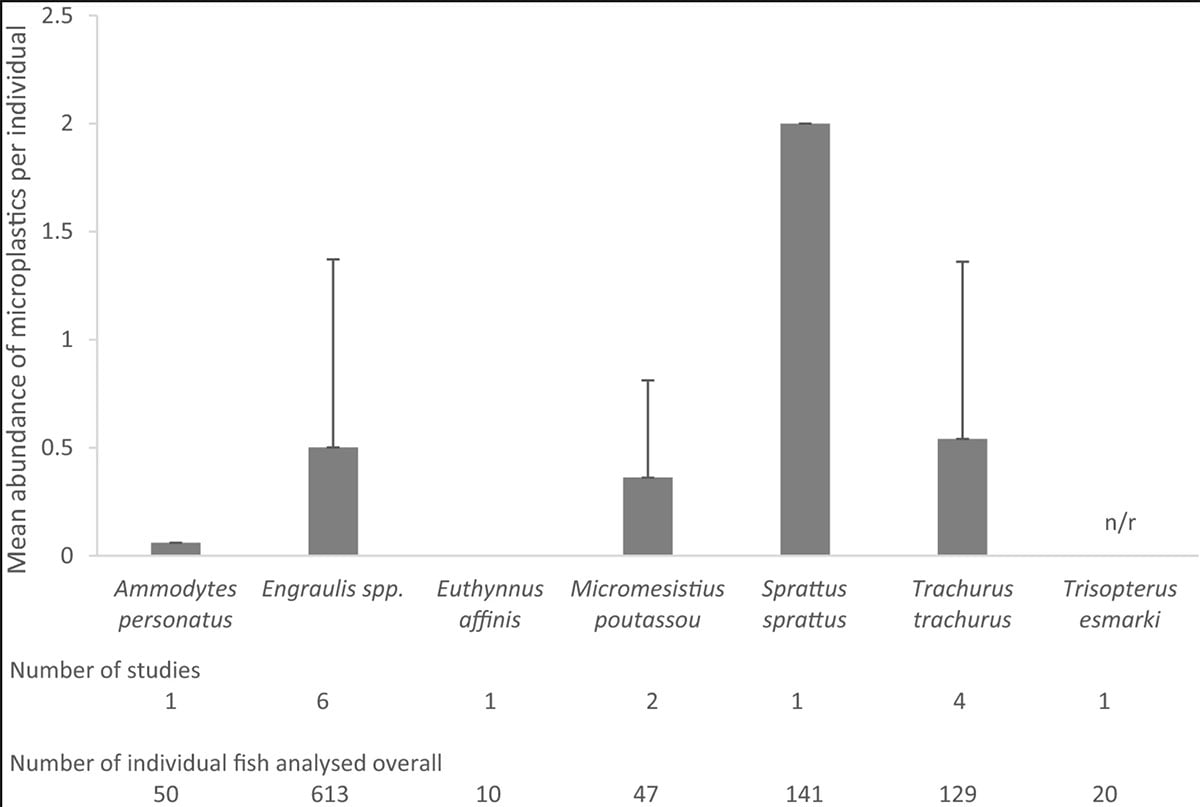
Did you notice the plastic in the stomach of that Rainbow Runner above? There were many different colors, and those are just the plastic we can see! When you looked at the chart above, you might have noticed that microplastics are found in the stomach of many of the fish studied. Undersea animals and fish may eat some strange things, but microplastics should never be on the menu. So how do microplastics get into the stomach of a fish in the first place?
Make A Visual Model
Take a moment to think about that question and create a visual model on your Microplastic Design Worksheet that explains your current ideas about where the plastic is from and how it gets into the stomach of fish. Be sure to include labels to help communicate your ideas and add questions where you’re unsure.
If you can, work with someone else and compare your models. Are there ideas that you might want to incorporate from that discussion?
Ask An Expert: What The Heck Are Microplastics?
How Do Microplastics Get Into The Ocean?
One of the ways we can combat the “plastic smog”—clouds of microplastics in our oceans—is to prevent microplastics from entering waterways from stormwater runoff. Many major cities, though not all, rain and runoff drain and collect in a bioretention cell designed to remove pollutants from the water. Unfortunately, microplastics are too small to be caught, so when the water leaves the bioretention cell for the nearest river, lake, stream, or ocean, it carries these tiny, lethal pollutants into the marine food chain.
Let’s create a model of a bioretention cell to get a better understanding of how they work, and why small pollutants like microplastics are hard to trap.
Let’s Model A Bioretention Cell
Like we saw in the graph, microplastics of various sizes are getting in the ocean and also the ocean food chain. Think about the place you live during and after the rain, where is all the water going? Barring completely eliminating plastics, how can we design a cell that would help us prevent microplastics from getting washed out with that surface runoff? We can use a physical model to help us understand more about the problem before trying to develop a solution.
Materials
16-oz plastic bottle
X-acto knife or sharp scissors (Warning: X-acto knives are sharp! Please use under adult supervision or have an adult help you cut your materials.)
Soil
Gravel or pebbles
Aluminum tray
Glitter (or seed beads)
Water
Window screen squares
Cup
Bioretention Cell Building Protocol
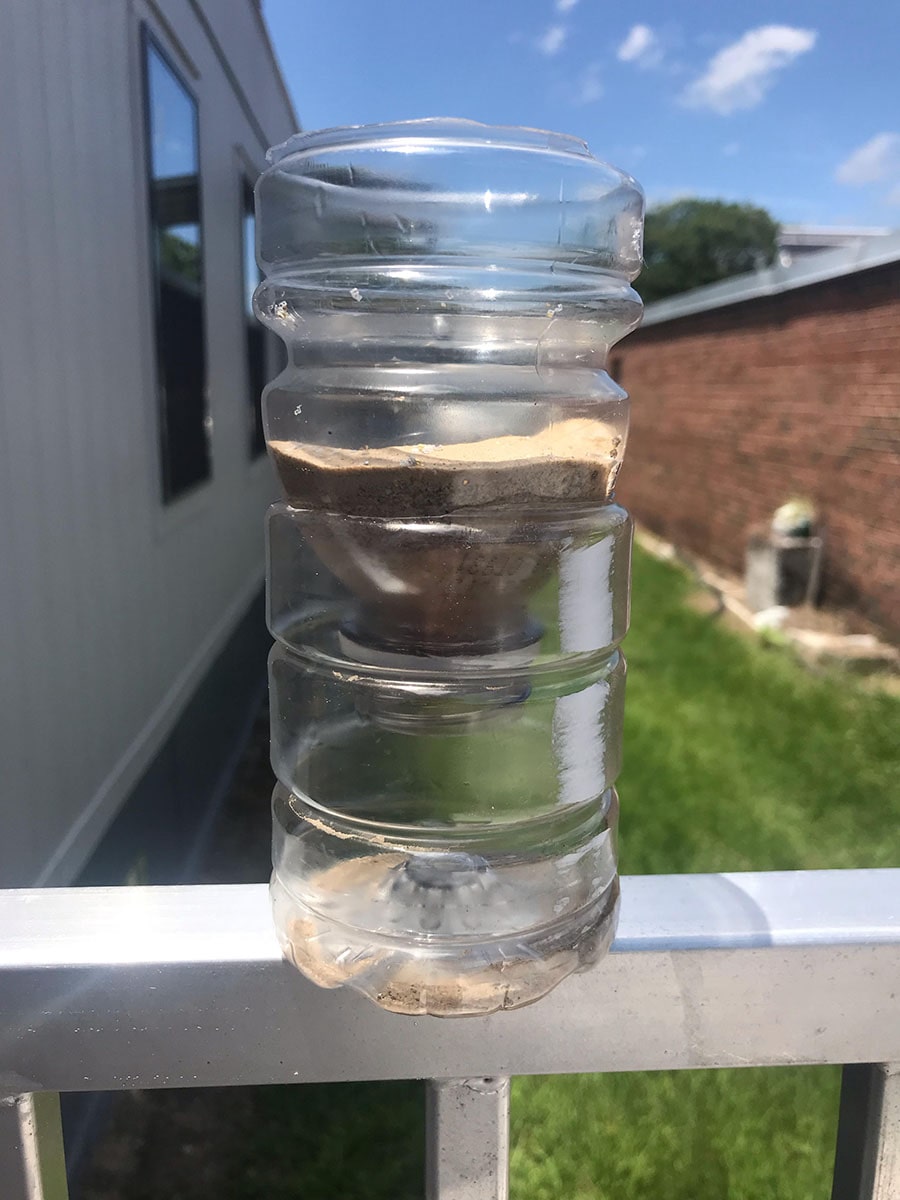
- Cut the water bottles in half.
- Cut a small hole halfway down the top half of each plastic bottle.
- Place the window screen in the top half of each plastic bottle, where the mouth is located.
- Fill half of the top half of one bottle with soil and the other bottle with gravel.
- Remove the cap and place the top half of each water bottle, mouth-end down, inside the bottom half.
- Place the two halves of the water bottles inside the aluminum tray.
- Mix water and glitter (or seed beads) in the cup.
- Pour the water-glitter mixture into the top half of each water bottle.
- Allow water to drain out the bottom and side of the water bottle.
- Once the water infiltrates and drains, add additional water-glitter mix to show what happens as your bioretention cell continues to receive water.
- Compare the results of the effluent for each water bottle.
Reflection Questions
- Looking at the evidence you collected in the activity, what can you now explain about our original phenomenon?
- What changes could be made to the model to help it filter water effectively without allowing microplastics into the discharged water? (If you have time, build and test it!)
Soil Engineering: The Relationship Between Soil Texture And Function
So What Is Going On?
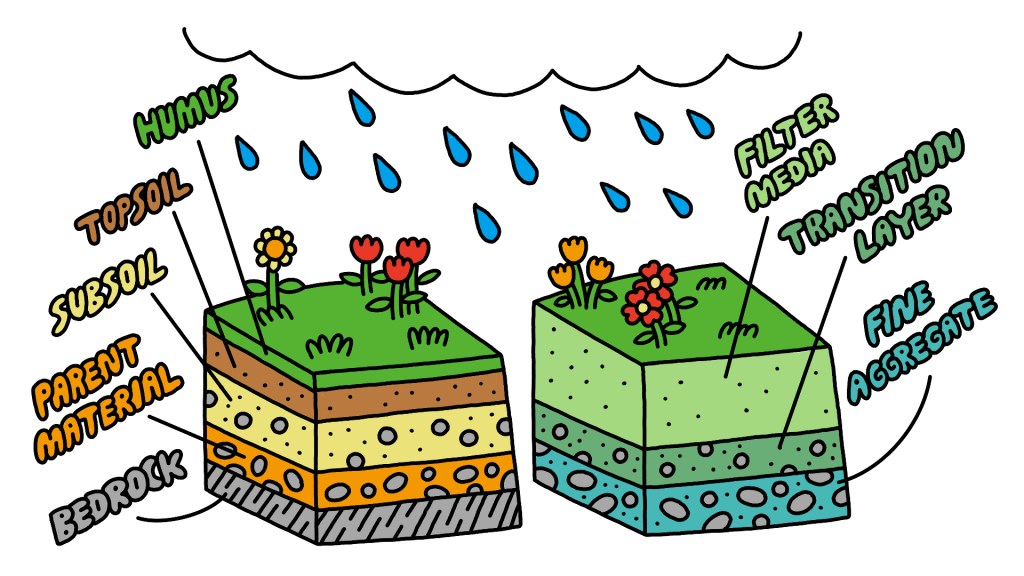
Biofiltration is the process of capturing stormwater runoff and using designed soils and vegetation to treat the captured stormwater. The bioretention cells are shallow, vegetated depressions that capture and hold stormwater runoff and allow it to infiltrate into the underlying soils. When designing a bioretention cell, it’s important to think about the filtration medium and underlying soils being used, and the size of the pollutant being filtered. Types of bioretention cells include bioswales, rain gardens, and detention ponds. Components of infiltration system design are water storage, pollution treatment, and infiltration.
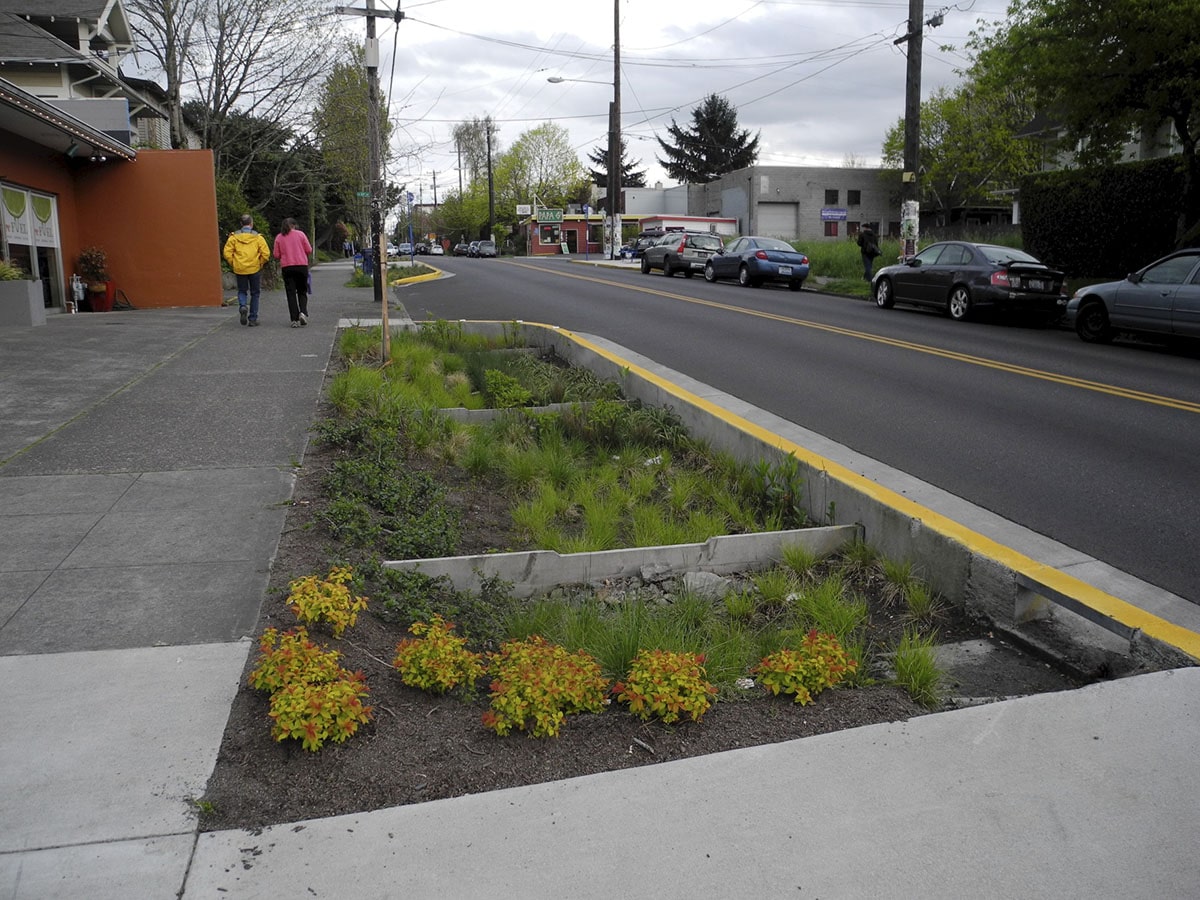
In typical bioretention cells, water flows laterally and vertically. The model you created focused on only the vertical movement of runoff and its contents within a bioretention cell. In a typical bioinfiltration system, water runs off from a drainage area (like a parking lot) and into the bioretention cell where it infiltrates, and filters out pollutants before they are discharged into a nearby waterway. The system is designed to capture those pollutants and allow them to break down over time, but some microplastics don’t break down and are discharged with the outflowing water.
It is important to design solutions to treating stormwater runoff that ensures they have limited effects on the environment. Currently, most biofiltration systems are not designed to filter out microplastics, allowing them to discharge those plastics along with the treated water. When bioretention cells don’t effectively remove microplastics coming from tires, clothing, and single-use plastics, effluent containing those microplastics can be discharged into the nearest waterway and affect marine life.
 This resource is part of Science Friday’s Educator Phenomena Forum and was developed collaboratively by Chenille Williams, an educator at the Richland County Department of Public Works, and Timnit Kefela, a Ph.D. candidate at University California Davis specializing in microplastics pathways. Click here for a folder of classroom resources.
This resource is part of Science Friday’s Educator Phenomena Forum and was developed collaboratively by Chenille Williams, an educator at the Richland County Department of Public Works, and Timnit Kefela, a Ph.D. candidate at University California Davis specializing in microplastics pathways. Click here for a folder of classroom resources.
Chenille Williams focuses on education about the proper ways to reduce stormwater pollution, including microplastics from illegally dumped tires and single-use plastics. We can help reduce the number of microplastics in the water by reducing our use of single-use and other plastic products. While Chenille works on stopping plastics from the source (us), Timnit Kefela is looking at the way microplastics are either broken down, adsorbed to the soil in bioretention cells, or discharged into a nearby water body. Through her work, we can design a more efficient biofiltration system to keep microplastics out of waterways.
Additional Resources
- Want to learn more about soil and how it functions? Try Soil Engineering!
- Check out more plastics information and advocacy with the Five Gyres Institute.
- Make a Water Filter
- Home Biofilters for Nutrient Removal
Next Generation Science Standards
This resource works toward the following performance expectations:
- MS-ESS3-3: Apply scientific principles to design a method for monitoring and minimizing a human impact on the environment.
- HS-ESS3-4: Evaluate or refine a technological solution that reduces impacts of human activities on natural systems.
Credits:
Written by Chenille Williams
Edits by Abigail Holstein and Xochitl Garcia
Advice and Review Timnit Kefela
Digital Production by Xochitl Garcia
Meet the Writers
About Chenille Williams
Chenille H. Williams is the education program coordinator for Richland County Stormwater Management in Columbia, S.C., she teaches students, professionals, educators, and homeowners about water quality issues and how to prevent surface water pollution through a blend of workshops, presentations, and community partnerships. Outside of being an educator, Chenille is a visual artist and loves learning about the fermentation process of kombucha.
About Timnit Kefela
@timisneatTimnit Kefela is a PhD candidate at the University of California, Santa Barbara’s Bren School of Environmental Science & Management, where she is focused on understanding the sources, pathways and fates of plastics in urban soil and marine environments. She is also a co-organizer for Black in Environment Week, which will be happening April 18-22, 2022.
